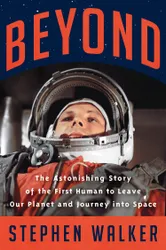This book tells the story of how Yuri Gagarin became the first human in space. The story is told in more or less chronological order, starting from around 1960 when the USSR were sending dogs into space, and covers both the Soviet and American projects to put a man (there was never any possibility of it being a woman at the time) into space first.
The politics of the cold war between the USA and USSR played a driving role in the space race. The Americans were behind from the start. The Soviets had already put the unmanned Sputnik satellite into orbit, and they had bigger, more powerful rockets enabling them to launch bigger spacecraft. The Soviet leader, Nikita Khruschev, used a series of Soviet achievements in space to claim superiority over the Americans, as President Kennedy urged the Americans to play catch up. In the process, the different political ideologies and approaches are highlighted and compared. The potential US astronauts were made public and were celebrities before any of them had reached space, while the Soviet cosmonauts, including Gagarin, were kept completely secret. Gagarin’s name was only released once he was already in space. Amusingly, he was also promoted to Major while in space, without knowing about it, because the USSR thought it sounded better for a Major to be the first man in space rather than a First Lieutenant. The political stakes were high enough for the US side to employ fomer Nazis, such as Wernher von Braun, to design their rockets. They were also designing rockets for nuclear weapons as well, and the space race and cold war nuclear proliferation are closely integrated on both sides.
What is conveyed really well in this book is the danger of these flights into space. The engineers involved were doing this for the first time, and there were so many things that could go wrong. Almost every flight described in the book had something that went wrong, and in each case it could have been fatal had there been a human on board. Even the successful flights often had an element of luck to their success, with things going wrong but not fatally so. There are descriptions of some horrible accidents in the book which took the lives of both cosomonauts and engineers.
The early flights covered in the book usually contained animals, dummies or both. The animals involved, which were usually dogs on the Soviet side and chimpanzees on the American side, were often killed in the attempts, and those that survived suffered horribly on the way. Obviously the animals had no idea what was happening to them, despite being “trained” for space flight. The book doesn’t shy away from covering this less humane side of the space race. This may make these sections difficult reading for animal lovers.
We also meet engineers and project leaders, and the astronauts and cosmonauts themselves. A lot of the knowledge about the Soviet space project comes from Nikolai Kamanin, who was the chief of training for the cosmonauts. He was absolutely not allowed to keep a diary, but he did anyway, in secret, and was present for many of the key events. He was close to Sergei Korolev, a man whose identity was kept completely secret at the time, but who ran the Soviet space programme. Korolev is one of the most interesting characters in the book. He’s driven to conquer space, politically savvy enough get approval for his programme despite the cost, but he’s also a kind of father figure to the cosmonauts. The book follows the stories of the contenders to be the first human in space, on both sides. What struck me was how much they all really wanted it to be them, despite the life threatening danger in being chosen. Although they worked as a team most of the time, they were also jealous of those that were chosen to be first.
The flights themselves, of both humans and animals, and of course Gagarin’s historic journey, are described in detail. Not only did Yuri Gagarin reach space, but he also orbited the planet. He kept notes and recorded a log of his journey, and I enjoyed the detailed description of his flight. After he lands, he finds himself suddenly the most famous person on the planet, and the book also describes what his life was like in the days following his flight.
I loved reading this book. The story is really exciting, and the political backdrop to the space race makes it a vivid history lesson. Although there isn’t a huge amount of science in this book, I did enjoy the descriptions of the technology and engineering that went into these early space vehicles. It does a great job of conveying the ingenuity, risk and heroism of those involved, as well as the darker side, such as the humans and animals who died in the effort.
